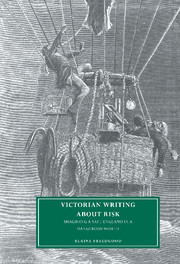Book contents
- Frontmatter
- Contents
- List of illustrations
- Acknowledgments
- Introduction: the practice of paradise
- 1 Banishing panic: J. R. McCulloch, Harriet Martineau and the popularization of political economy
- 2 The rhetoric of visible hands: Edwin Chadwick, Florence Nightingale and the popularization of sanitary reform
- 3 Groundless optimism: regression in the service of the ego, England and empire in Victorian ballooning memoirs
- 4 The uses of pain: cultural masochism and the colonization of the future in Victorian mountaineering memoirs
- 5 A field for enterprise: the memoirs of David Livingstone and Mary Kingsley
- Conclusion
- Notes
- Bibliography
- Index
- CAMBRIDGE STUDIES IN NINETEENTH-CENTURY LITERATURE AND CULTURE
4 - The uses of pain: cultural masochism and the colonization of the future in Victorian mountaineering memoirs
Published online by Cambridge University Press: 06 September 2009
- Frontmatter
- Contents
- List of illustrations
- Acknowledgments
- Introduction: the practice of paradise
- 1 Banishing panic: J. R. McCulloch, Harriet Martineau and the popularization of political economy
- 2 The rhetoric of visible hands: Edwin Chadwick, Florence Nightingale and the popularization of sanitary reform
- 3 Groundless optimism: regression in the service of the ego, England and empire in Victorian ballooning memoirs
- 4 The uses of pain: cultural masochism and the colonization of the future in Victorian mountaineering memoirs
- 5 A field for enterprise: the memoirs of David Livingstone and Mary Kingsley
- Conclusion
- Notes
- Bibliography
- Index
- CAMBRIDGE STUDIES IN NINETEENTH-CENTURY LITERATURE AND CULTURE
Summary
“The view is superb, but you dare not look at it.”
Albert Smith, The Story of Mont Blanc (1854)In the previous chapter, we saw that the pleasures recounted in ballooning memoirs disrupt the idea of risk as predominately painful and therefore deserving of reward. In canonical adventure stories from The Odyssey to Heart of Darkness, rewards for risk generally come only at the end of the story. In ballooning memoirs, by contrast, rewards for risk are continuous: pleasures of various kinds are experienced by balloon travelers even in the midst of considerable danger. Mountaineering memoirs disturb canonical stories of risk by suggesting that the pain of risk has its pleasures and uses; indeed, for some, pain may be its own reward. In the memoirs of five mountaineers – Leslie Stephen, A. F. Mummery, Edward Whymper, Amelia Edwards and Frederica Plunket – pain makes and unmakes the subject and the world, providing pleasure and power to those who are willing to risk experiencing it.
The mountaineers considered in this chapter are a diverse group, but they shared everyday lives that were socially and economically secure, and largely sedentary. Edwards was a novelist, traveler and Egyptologist; Stephen was a major Victorian intellectual, the founding editor of the Dictionary of National Biography, and the author of numerous volumes of history, biography and criticism. Mummery was a wealthy businessman and political economist who co-authored a book on industry with J. A. Hobson.
- Type
- Chapter
- Information
- Victorian Writing about RiskImagining a Safe England in a Dangerous World, pp. 99 - 131Publisher: Cambridge University PressPrint publication year: 2000
- 1
- Cited by



